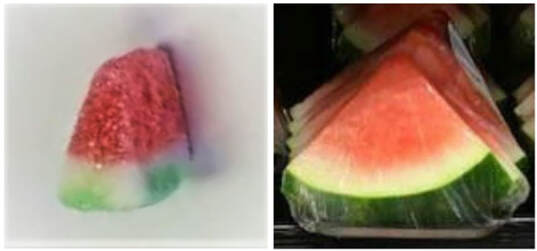
roduct design may be granted trademark protection, termed “trade dress” under federal trademark law. But one established limitation is that the design cannot be “functional.” The Supreme Court has defined that to mean either (1) when the claimed design is essential to the purpose of the article or affects the cost or quality of the article, or (2) if protecting the design choice “would put competitors at a significant non-reputation-related disadvantage, meaning if it is competitively necessary to use the feature of the design in the relevant market.
A recent Third Circuit decision, PIM Brands Inc. v. Haribo of America Inc., 81 F.4th 317 (3d Cir. 2023) highlights the functionality bar. The case involved a dispute over the design of a candy, specifically a wedge-shaped watermelon-flavored candy with red, white and green colors. The plaintiff Pim Brands claimed trade dress rights in that design. The Third Circuit rejected that claim, because the design was functional.
First, the Third Circuit noted that functionality is “not a high bar.” So long as the design adds any advantage to the product (other than the reputational association with the trade dress owner), it is functional. In the case of the candy, the shape and colors identified the flavor of the candy. That rendered the design functional.
The functionality inquiry is whether the design is “as a whole functional,” as stated expressly in the Lanham Act. 15 U.S.C. § 1052(e)(5). How should a court evaluate that when different aspects of the trade dress are asserted to render it functional. The Pim Brands decision sheds light on that question.
Pim Brands argued that the wedge shape should have been evaluated for functionality separate from the color scheme. But the Third Circuit rejected that argument, since both the wedge shape and the color scheme served the same function: identifying the flavor. So the two aspects – shape and color – should be evaluated together.
The Third Circuit distinguished its prior decision in Ezaki Glico Kabushiki Kaisha v. Lotte Int’l Am. Corp., 986 F.3d 250 (3d Cir. 2021), another candy case, where the plaintiff claimed trade dress rights in a design for cookies shaped into sticks and coated partly with chocolate. The Third Circuit had held the design functional because the stick shape let it fit more cookies into each package, and dipping only part of the stick in chocolate helped people eat it without getting chocolate on their hands.
The Third Circuit explained that in Ezacki Glicko, the two aspects performed different functions, and so were analyzed separately. In Pim Brands, in contrast, the two features performed the same function. In that circumstances, the Third Circuit held, the two aspects would be analyzed together.
Ultimately, The Third Circuit concluded that the wedge-shaped, green-white-red colored candy, immediately brought to mind a slice of watermelon. That identified the flavor as watermelon, rendering the design functional.
A recent Third Circuit decision, PIM Brands Inc. v. Haribo of America Inc., 81 F.4th 317 (3d Cir. 2023) highlights the functionality bar. The case involved a dispute over the design of a candy, specifically a wedge-shaped watermelon-flavored candy with red, white and green colors. The plaintiff Pim Brands claimed trade dress rights in that design. The Third Circuit rejected that claim, because the design was functional.
First, the Third Circuit noted that functionality is “not a high bar.” So long as the design adds any advantage to the product (other than the reputational association with the trade dress owner), it is functional. In the case of the candy, the shape and colors identified the flavor of the candy. That rendered the design functional.
The functionality inquiry is whether the design is “as a whole functional,” as stated expressly in the Lanham Act. 15 U.S.C. § 1052(e)(5). How should a court evaluate that when different aspects of the trade dress are asserted to render it functional. The Pim Brands decision sheds light on that question.
Pim Brands argued that the wedge shape should have been evaluated for functionality separate from the color scheme. But the Third Circuit rejected that argument, since both the wedge shape and the color scheme served the same function: identifying the flavor. So the two aspects – shape and color – should be evaluated together.
The Third Circuit distinguished its prior decision in Ezaki Glico Kabushiki Kaisha v. Lotte Int’l Am. Corp., 986 F.3d 250 (3d Cir. 2021), another candy case, where the plaintiff claimed trade dress rights in a design for cookies shaped into sticks and coated partly with chocolate. The Third Circuit had held the design functional because the stick shape let it fit more cookies into each package, and dipping only part of the stick in chocolate helped people eat it without getting chocolate on their hands.
The Third Circuit explained that in Ezacki Glicko, the two aspects performed different functions, and so were analyzed separately. In Pim Brands, in contrast, the two features performed the same function. In that circumstances, the Third Circuit held, the two aspects would be analyzed together.
Ultimately, The Third Circuit concluded that the wedge-shaped, green-white-red colored candy, immediately brought to mind a slice of watermelon. That identified the flavor as watermelon, rendering the design functional.
